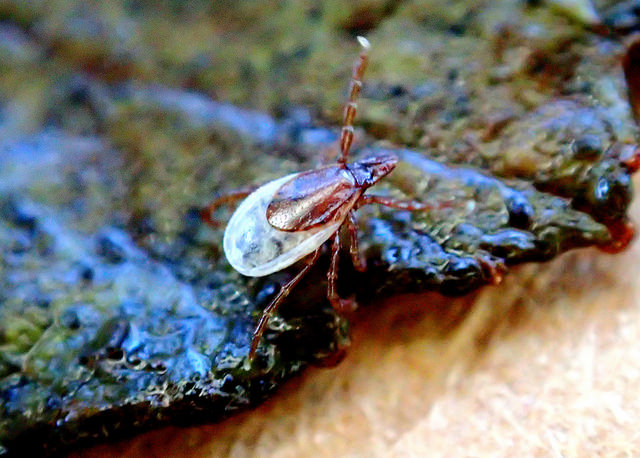Lyme bacteria settled in North America far earlier than we thought
Insight into the disease’s ancient origins points toward the causes of the current epidemic
Jen Monnier • November 29, 2017

A black-legged tick, one of the common carriers and spreaders of Lyme disease in the Eastern and Midwest United States. [Image credit: Brenda Dobbs| CC-BY-NC 2.0]
While the Lyme disease outbreak in people dates back only about 40 years, the bacterium that causes this disease has called North America home for more than 20,000 years, according to a study published in August in the journal Nature Ecology and Evolution.
The epidemic began when a set of strange symptoms, including swollen knees and skin rashes, cropped up in people in the 1970s in Lyme, Connecticut. The disease was later attributed to the bacterium Borrelia burgdorferi. The new study unveils this bacterium’s geographic history and leads its authors to believe the current Lyme disease epidemic resulted from recent ecological changes rather than changes in the disease bacterium itself.
“The bacteria have been here for a long time in North America – long before the last ice age, long before humans even arrived,” says lead author Katharine Walter, who studies the epidemiology of microbial diseases at Yale University. “Not only has it been present, the diversity of the bacteria is also ancient.”
Walter played a big role in the research in and out of the lab. She and her sister camped around the northeastern United States for an entire summer. The pair gathered more than 7,000 black-legged ticks, which carry of the Lyme bacterium, using a method called dragging. The technique involves slowly pulling 1 square meter of corduroy cloth along the forest floor. Thirsty ticks mistake the cloth for a mammal and latch on. “It’s kind of fun. It feels like you’re taking a dog – a very inactive dog – on a walk,” Walter says.
Other researchers from institutions in the Midwestern United States and southern Canada contributed ticks to the project as well. Walter’s team sequenced the bacteria from this tick bounty, yielding the largest collection of Lyme disease bacteria genomes to date, according to the study. These genomes catalogued the bacterium’s evolutionary history. The researchers identified genetic strains in bacteria from each geographic region. By comparing the differences between the strains, the scientists could estimate how quickly they evolved.
The genomes revealed an unexpected history. The bacteria have ancient history in North America, with an unexpectedly diverse swath of genetic strains. The bacterium’s geographic history was also surprising. Researchers had long thought that it spread from the Northeast to genetically isolated clumps throughout the continent. Instead, Walter and her team found that the bacteria migrated, and continue to migrate, between the Northeast, South and Midwest regions of the continent, mixing and spreading continuously. They move throughout North America on ticks clung to deer, mice and birds, like letters strapped to horses on the Pony Express.
The bacterium’s widespread and diverse genetic history on this continent for tens of thousands of years provides new insights into the Lyme disease epidemic in people.
Until now, scientists have pointed to evolutionary change, or a new bacteria strain, as the reason the disease emerged and spread in people. Walter and her team have ruled out these possibilities with this new research. “That means there’s some other change that has allowed the bacteria to spread incredibly rapidly,” Walter says. Her team leans on others’ research to deduce that the epidemic stemmed from ecological changes, such as climate change and animal habitats shrunken and fragmented by human land use.
This research adds to the story of Lyme in North America – how it arose, evolved and how people have influenced its spread. The story is far from complete, though, as researchers like Walter continue to tromp through the woods finding more evidence to fill in the blanks.
4 Comments
Lyme disease was spread from Plum island agricultural government research facility. It was crafted for the military to infiltrate enemy’s armed forces and wear them down with illness. It got released on to Lyme Conn. via birds where it got it’s name. Now it is the most and worst disease epidemic in the United States and other countries. We are trying to cover it all up now but it’s really too late.
Appreciate the article and how well written, concise, yet informative. I plan on using this in my Science Class as a learning tool for my students
If the researchers investigate the use of borrelia in aerosols by the Japanese when fighting the Chinese, they might find some answers in how it has spread so fast… cross reference with geo-engineering and aerosol chem trails.
…along with Plum Island and weaponization of the bacteria.